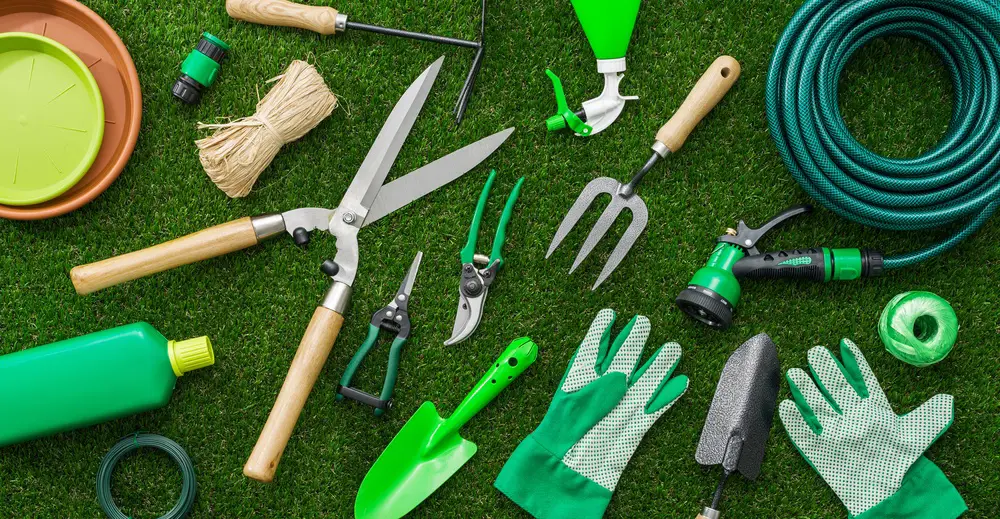Garden tools lose their sharpness after a couple of seasons of service. Working with dull tools is not only tedious, but it leaves plants prone to disease. A dull lawnmower blade, for example, makes the grass on your lawn susceptible to pests. There are different ways of sharpening garden tools.
Files and mill files are ideal for reconditioning cutting edges, but if the garden tools are severely damaged, a bench grinder comes in handy. The idea is to use a grinding wheel that rids off the chipped metal without overheating the tool as it ruins its hardness. A 60-grit aluminum oxide wheel that has a medium hardness rating is suitable. We look at how to sharpen different garden tools using a bench grinder.
Check Out: Bench Grinders for the Gardener
Tools Required
- Bench grinder
- Garden shears
- Lawnmower blades
- Knives
- Axe
- Trowel
- Sandpaper
- Clamp
- Safety goggles or face shield
- Gloves
Procedure
Soak the Tools in an Oven
Soak the tools in an oven before you start sharpening them on the bench grinder. The gradual heat prevents the metal from cracking when sharpening. You should set the oven at 350 degrees Fahrenheit and leave the tools in the oven for two hours. Then, remove tools from the oven and allow them to cool before you start sharpening.
Sharpening Lawnmower Blades
The only difficult about sharpening these blades is removing them from the mower. Ensure you disconnect the equipment from the power source and remove the spark plug before taking out the blade. Then, turn the mower over and unfasten the blade from the mower.
Pay attention to the up and down sides as it is easy to put the blade back the wrong way. You can use a marker pen to help you identify the sides. Then clean the blade using sandpaper and begin to sharpen it on the bench grinder.
Start working on the mushroomed ends creating a 45-degree bevel angle. Turn the tool against the direction the wheel is spinning while grinding away the mushroomed surface.
Sharpening Garden Knives
Knives get blunt fast after a few uses. Start with the coarse-grit wheel applying moderate pressure. Be sure to set the knife at an angle of 20 degrees on the tool rest. Repeat the process using the fine-grit wheel to achieve an extra-sharp edge. Note that knife blades don’t need to be beveled.
Sharpening Garden Shears
Garden shears have two beveled edges that need to be sharpened. A basic mill file and a clamp will do the trick, but if the shears have bends and nicks, you need to sharpen them on a bench grinder. Use high-grit sandpaper to remove rust or thick layers of grime before sharpening. If sharpening a small pair of shears, you may need to use a clamp.
Sharpening an Axe
Axes are made of hard metals hence the need to use strong tools to sharpen them. Move the blade back and forth over the grinding wheel, applying moderate pressure. Begin sharpening one side and repeat the process for the other cutting edge. It is essential to wear safety goggles when sharpening to protect your eyes.
Shovel
Shovels with curved edges need to be sharp to penetrate tough soil, ice, roots, and other material. Periodic sharpening and cleaning keep the edge crisp and sharp. A bench grinder is ideal for shovels that have developed nicks and dings as it helps buff out the edges. Pass the edges over the wheel until the nicks are smoothed out.
Trowel
Some people like their garden trowels sharp and clean. It does not need much grinding as it does not slice through tough surfaces. Also, over-sharpening it shortens its lifespan. You may need to sand it a little before grinding to remove rust or dirt.
For You: 5 of Our favorite Bench Grinders
Hoe
It also does not need much sharpening as it is used for dragging or scraping. The procedure is just as that of a trowel. First, clean the hoe using sandpaper to remove dirt and rust. Then grind it on the fine-grit wheel until you achieve a sharp edge.
Additional Tips
- Avoid removing the tool from the wheel after one pass
- Avoid overheating the tool when sharpening
- Sharpen the tool regularly
- Quench the tool in oil or water before turning its edge to the wheel
- Apply some lubricant over the tools after sharpening


